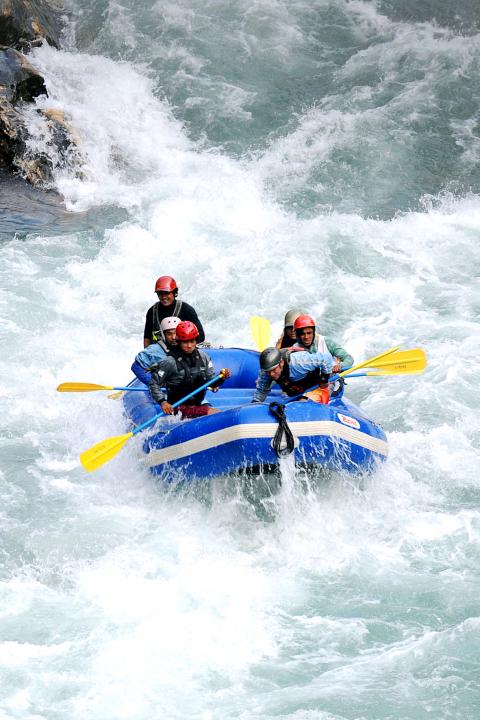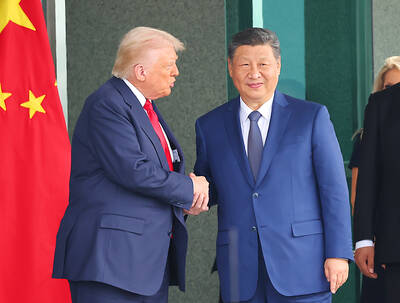The Bhote Koshi river rises in Tibet and cuts a mighty swathe through the Himalayas, carving out gorges as it tumbles into Nepal in a series of thundering rapids.
Regarded as one of the best waterways in the world for whitewater rafting, the river attracts thrill-seekers of all nationalities, keen to test their mettle in the adrenaline-pumping sport.
Since the end of Nepal’s 10-year civil war in 2006, a surge in popularity has made rafting a multi-million dollar industry and a vital contributor to tourism in the impoverished nation. However, many sections of Nepal’s famed river network could soon be tamed as the energy-starved country plans a huge expansion in hydro-electricity in the face of a shortage that has brought power cuts lasting up to 16 hours a day.

Photo: AFP
“When people talk about whitewater rafting, they think of the Bhote Koshi river. It is for adventure seekers what Everest and Annapurna are for climbers,” Nepal River Conservation Trust president Megh Ale said. “So, it is the world’s heritage — not only Nepal’s. We are not against development in itself, but the government should clearly state which river is for what.”
Experts say Nepal’s mountain river system could be generating 83,000 megawatts of power. The nation currently produces a paltry 692 megawatts.
Nepal’s dire power shortage has crippled industry and dissuaded foreign investment, with crucial infrastructure development having ground to a halt in the years of political paralysis following the 1996-2006 Maoist insurgency. The country has 23 hydropower plants, according to the Independent Power Producers’ Association Nepal, but a further 36 have been mooted or are already being built.
One plant under construction on the Bhote Koshi will include a gated weir near the Tibetan border, choking the fast flow of water for rafters, with may people expressing horror at the threat to their sport.
Five major resorts and 21 rafting companies operate along its banks, bringing in more than 100,000 tourists a year and providing hundreds of jobs.
Campaigners have called on the government to take rafting into account when planning locations for hydropower projects.
However, the energy industry insists power generation in the impoverished nation should take priority over adventure.
“Hydropower development is the need of the hour,” Welcome Energy Development Co general manager L.B. Thapa said. “We should ask the right question — what is the need of our country? Is it energy or rafting?”
The Chilime Hydropower Co, which is behind the Bhote Koshi project, insists it would lose half of its capacity and all its profits were it to build further away from rafting hotspots.
“We are not against tourism. We believe that the sector needs to flourish,” Chilime Hydropower general manager Prakash Shrestha said. “But if we go by the theory of utilization of water, the first priority should be given to drinking water, second to irrigation, third hydropower and only then rafting.”
Whitewater rafting was introduced to Nepal in the middle of the 1970s by foreign diplomats and has been embraced by tourism businesses who now offer packages to holidaymakers lasting up to 12 days.
Chudamani Aryal, 37, has spent 16 years as a rafting guide on Nepal’s longest river, the Karnali, which flows through dense forest near the Bardiya National Park in the country’s south. For him, the appeal is clear.
“We start off as soon as the sun rises to see crocodiles come ashore to bask in the sun. We come across spotted deer, barking deer and other rare animals like endangered dolphins,” Aryal said. “The tourists constantly say ‘wow.’ We can see the glow of satisfaction on their faces. We should not sacrifice all this for the sake of hydropower development.”
Indian developer GMR is building a 900 megawatt hydro plant, which Aryal believes will severely curtail rafting on the Karnali, reducing its appeal to foreign tourists who may go elsewhere in search of thrills.
Tourism contributes more than US$1 billion to the economy and the Nepal River Conservation Trust says rafting pulls in more than 20 percent of foreign holidaymakers, counted at a record 719,547 visitors last year.
“We have nearly 6,000 streams and rivers. Why can’t we spare some for rafting? We need to promote nature-based tourism,” Ale said. “Countries that don’t have any natural beauty erect buildings to attract tourism. Despite being bestowed with immense natural beauty, we are destroying it.”

Nissan Motor Co has agreed to sell its global headquarters in Yokohama for ¥97 billion (US$630 million) to a group sponsored by Taiwanese autoparts maker Minth Group (敏實集團), as the struggling automaker seeks to shore up its financial position. The acquisition is led by a special purchase company managed by KJR Management Ltd, a Japanese real-estate unit of private equity giant KKR & Co, people familiar with the matter said. KJR said it would act as asset manager together with Mizuho Real Estate Management Co. Nissan is undergoing a broad cost-cutting campaign by eliminating jobs and shuttering plants as it grapples

TEMPORARY TRUCE: China has made concessions to ease rare earth trade controls, among others, while Washington holds fire on a 100% tariff on all Chinese goods China is effectively suspending implementation of additional export controls on rare earth metals and terminating investigations targeting US companies in the semiconductor supply chain, the White House announced. The White House on Saturday issued a fact sheet outlining some details of the trade pact agreed to earlier in the week by US President Donald Trump and Chinese President Xi Jinping (習近平) that aimed to ease tensions between the world’s two largest economies. Under the deal, China is to issue general licenses valid for exports of rare earths, gallium, germanium, antimony and graphite “for the benefit of US end users and their suppliers

Dutch chipmaker Nexperia BV’s China unit yesterday said that it had established sufficient inventories of finished goods and works-in-progress, and that its supply chain remained secure and stable after its parent halted wafer supplies. The Dutch company suspended supplies of wafers to its Chinese assembly plant a week ago, calling it “a direct consequence of the local management’s recent failure to comply with the agreed contractual payment terms,” Reuters reported on Friday last week. Its China unit called Nexperia’s suspension “unilateral” and “extremely irresponsible,” adding that the Dutch parent’s claim about contractual payment was “misleading and highly deceptive,” according to a statement

The Chinese government has issued guidance requiring new data center projects that have received any state funds to only use domestically made artificial intelligence (AI) chips, two sources familiar with the matter told Reuters. In recent weeks, Chinese regulatory authorities have ordered such data centers that are less than 30 percent complete to remove all installed foreign chips, or cancel plans to purchase them, while projects in a more advanced stage would be decided on a case-by-case basis, the sources said. The move could represent one of China’s most aggressive steps yet to eliminate foreign technology from its critical infrastructure amid a